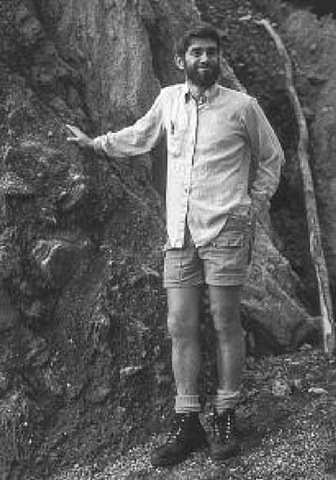(1943- ) American Geophysicist, Tectonics
The type of continent-continent collision on Earth between northern India and southeastern Asia built not only the Himalayas, the highest mountain range in the world, but also the Tibetan Plateau and mountain ranges to the north, among others. Peter Molnar is one of the foremost experts on this area. His goal has been to bring a simple understanding to the dynamic processes of mountain building and the mechanics of the continental collision using this great example. In 1975, he and Paul Tapponnier showed that the active deformation of Eurasia from the Himalayas to Lake Baikal in Siberia, some 1,800 miles to the north, results from this collision. This work is summarized in the paper, “Active Deformation of Asia from Kinematics to Dynamics,” among others. The continuing penetration of the Indian continent into Asia forced large areas of the Asian landmass to move laterally out of the way of this collision. Bulk movement of continental mass out of the way of the colliding plate was accommodated by literally thousands of miles of strike-slip movement. This new class of strike-slip fault rivals the plate bounding transform faults like the San Andreas fault in California. The bulk movement is called “escape” or “extrusion” tectonics and is analogous to smashing a fist into a handful of clay, forcing it to squirt out of the sides. In Asia, the bulk movement was to the east mostly along the Red River and Altyn
Peter Molnar at a rock exposure at the Alpine Fault in New Zealand in 1984
Tagh faults, forcing Indochina to squeeze and rotate into its present configuration.
This groundbreaking research is not the only important contribution to geology that Peter Molnar has made. He also studies the constraints on how high mountains can grow. With several researchers including Philip England (Oxford University), Molnar has placed constraints on crustal thickening in the Tibetan Plateau as the result of the compression of collision. The rheologi-cal properties of the crust only allow mountains to grow to a certain height. Even in a highly com-pressional environment the mountains will collapse by normal faulting and crustal extension.
Since 1990, Peter Molnar has been studying the impact of tectonic processes on climate change. He proposed that mantle processes beneath the Tibetan Plateau might have triggered rapid uplift, which in turn strengthened the Indian monsoon approximately 8 million years ago. Mark Cane of Columbia University and Molnar have proposed that the northward movement of Australia and New Guinea closed the Indonesian Seaway and cooled the waters of the Indian Ocean. This cooling affected the aridification of East Africa at the time that humans evolved. This idea is reported in the paper, “Late Cenozoic Closing of the Indonesian Seaway as the Missing Link between the Pacific and East African Aridi-fication.” The blockage of warm water in the western Pacific Ocean ended the perpetual El Nino conditions that prevailed before the sporadic El Nino conditions seen today. They attribute the onset of ice ages roughly 3 million years ago to a decrease in heat transport from the tropics. With maureen e. raymo, Molnar has been investigating changes in climate as the result of the massive Himalayan mountain building. The two were featured on a well-received NOVA television special.
Peter Molnar was born on August 25, 1943, in Pittsburgh, Pennsylvania. He moved several times during his childhood, attending both Highland High School, Albuquerque, New Mexico (1958-60) and Summit High School, Summit, New Jersey (1960-61), where he played forward on Summit’s champion basketball team. He attended Oberlin College, Ohio, from 1961 to 1965 and earned a bachelor of arts degree in physics and was cocaptain of the lacrosse team. He completed his graduate studies at Columbia University in New York (1965-1970) and earned a Ph.D. in seismology. From 1970 to 1971, he was a research scientist at the Lamont-Doherty Geological Observatory of Columbia University. From 1971 to 1973, Molnar was an assistant research scientist at Scripps Oceanographic Institute, University of California at San Diego. He was also a National Academy of the Sciences exchange scientist with the USSR for four months in 1973-74. Peter Mol-nar joined the faculty at Massachusetts Institute of Technology (MIT) in 1974. He served as a visiting scientist at numerous institutions during his tenure at MIT, including Oxford University, England, and Institut de Physique du Globe, Paris, France, among others. In 1986, he quit the faculty at MIT and switched to the research staff. In 2001, he joined the faculty at the University of Colorado at Boulder where he is currently a half-time professor. Molnar has one child from his previous marriage to tanya atwater. Peter Molnar married Sara Neustadt in 1986.
Peter Molnar is an author of numerous scientific articles in international journals and professional volumes. Many of these papers are classic studies on the Himalayas and mountain-building processes. He has received numerous honors and awards for these contributions to the field. Molnar had a Higgins Fellowship in graduate school and a Sloan Fellowship during his first four years at MIT. He was a Guggenheim Fellow in 1980, studying at Cambridge University, England. He was a Harold Jeffreys lecturer, Royal Astronomical Society, London, England, in 1996 and a F.A. Vening Menesz lecturer, Utrecht University, Netherlands, in 1999. Molnar also received an Editor’s Citation from American Geophysical Union in 2000.

